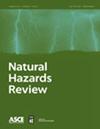Estimating Pluvial Depth–Damage Functions for Areas within the United States Using Historical Claims Data
IF 1.8
3区 工程技术
Q3 ENGINEERING, CIVIL
引用次数: 1
Abstract
Flooding has been the most costly natural disaster over the last 2 decades within the US. Therefore, recent research has focused on more accurately predicting economic losses from flooding to aid decision makers and mitigate economic exposure. For this, depth–damage functions have commonly been employed to predict the relative or absolute damage to buildings caused by different magnitudes of flooding. Although depth–damage functions, such as those adopted by the US Army Corps of Engineers, are widely available for fluvial and coastal flooding, less work has been done to develop functions for pluvial-induced flooding. Here, we use a database containing 13.5 million claims to develop pluvial depth–damage functions. For this, recently released flood hazard data are utilized to identify claims within the database that are likely related to pluvial flooding. We employed two types of regression models to fit the depth–damage functions. Secondarily, we developed an automated valuation model (AVM) to estimate building values across the state of New Jersey. These building values were then combined with flood hazard layers in order to apply the depth–damage functions and compute an aggregate annualized loss for New Jersey. The results indicated moderate agreement between the observed damage within the state of New Jersey and that computed by applying the study-developed depth–damage curves to buildings within the state using pluvial flood hazard layers. It is anticipated that the depth–damage functions developed by this research will aid future work in more accurately quantifying the economic risks associated with flooding across the US.利用历史索赔数据估算美国境内地区的洪水深度损害函数
洪水是美国过去20年来损失最大的自然灾害。因此,最近的研究集中在更准确地预测洪水造成的经济损失,以帮助决策者减轻经济风险。因此,深度破坏函数通常被用来预测不同震级的洪水对建筑物造成的相对或绝对破坏。虽然深度破坏函数,如美国陆军工程兵团所采用的,广泛用于河流和沿海洪水,但很少有工作用于开发洪水引起的洪水的函数。在这里,我们使用包含1350万索赔的数据库来开发洪水深度损害函数。为此,最近发布的洪水灾害数据被用于识别数据库中可能与洪水有关的索赔。我们采用了两种回归模型来拟合深度-损伤函数。其次,我们开发了一个自动估价模型(AVM)来估计整个新泽西州的建筑价值。然后将这些建筑价值与洪水危险层相结合,以便应用深度损害函数并计算新泽西州的年化总损失。结果表明,新泽西州内观测到的破坏与将研究开发的深度破坏曲线应用于该州内使用洪积洪水危险层的建筑物所计算的破坏之间存在适度的一致性。预计本研究开发的深度损害函数将有助于未来更准确地量化与美国洪水相关的经济风险。
本文章由计算机程序翻译,如有差异,请以英文原文为准。
求助全文
约1分钟内获得全文
求助全文
来源期刊

Natural Hazards Review
ENGINEERING, CIVIL-GEOSCIENCES, MULTIDISCIPLINARY
CiteScore
4.90
自引率
7.40%
发文量
72
审稿时长
3 months
期刊介绍:
The Natural Hazards Review addresses the range of events, processes, and consequences that occur when natural hazards interact with the physical, social, economic, and engineered dimensions of communities and the people who live, work, and play in them. As these conditions interact and change, the impact on human communities increases in size, scale, and scope. Such interactions necessarily need to be analyzed from an interdisciplinary perspective that includes both social and technical measures. For decision makers, the risk presents the challenge of managing known hazards, but unknown consequences in time of occurrence, scale of impact, and level of disruption in actual communities with limited resources. The journal is dedicated to bringing together the physical, social, and behavioral sciences; engineering; and the regulatory and policy environments to provide a forum for cutting edge, holistic, and cross-disciplinary approaches to anticipating risk, loss, and cost reduction from natural hazards. The journal welcomes rigorous research on the intersection between social and technical systems that advances concepts of resilience within lifeline and infrastructure systems and the organizations that manage them for all hazards. It offers a professional forum for researchers and practitioners working together to publish the results of truly interdisciplinary and partnered approaches to the anticipation of risk, loss reduction, and community resilience. Engineering topics covered include the characterization of hazard forces and the planning, design, construction, maintenance, performance, and use of structures in the physical environment. Social and behavioral sciences topics include analysis of the impact of hazards on communities and the organizations that seek to mitigate and manage response to hazards.
 求助内容:
求助内容: 应助结果提醒方式:
应助结果提醒方式:


